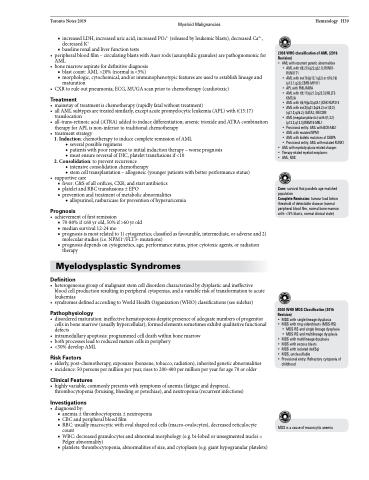Page 579 - TNFlipTest
P. 579
Toronto Notes 2019 Myeloid Malignancies
■ increased LDH, increased uric acid, increased PO43- (released by leukemic blasts), decreased Ca2+, decreased K+
■ baseline renal and liver function tests
• peripheralbloodfilm–circulatingblastswithAuerrods(azurophilicgranules)arepathognomonicfor
AML
• bonemarrowaspiratefordefinitivediagnosis
■ blast count: AML >20% (normal is <5%)
■ morphologic, cytochemical, and/or immunophenotypic features are used to establish lineage and
maturation
• CXRtoruleoutpneumonia;ECG,MUGAscanpriortochemotherapy(cardiotoxic)
Treatment
• mainstayoftreatmentischemotherapy(rapidlyfatalwithouttreatment)
• allAMLsubtypesaretreatedsimilarly,exceptacutepromyelocyticleukemia(APL)witht(15:17)
translocation
• all-trans-retinoic acid (ATRA) added to induce differentiation; arsenic trioxide and ATRA combination
therapy for APL is non-inferior to traditional chemotherapy • treatmentstrategy
1. Induction: chemotherapy to induce complete remission of AML
◆ several possible regimens
◆ patients with poor response to initial induction therapy – worse prognosis ◆ must ensure reversal of DIC, platelet transfusions if <10
2. Consolidation: to prevent recurrence
◆ intensive consolidation chemotherapy
◆ stem cell transplantation – allogeneic (younger patients with better performance status)
• supportivecare
■ fever: C&S of all orifices, CXR, and start antibiotics
■ platelet and RBC transfusions ± EPO
■ prevention and treatment of metabolic abnormalities
◆ allopurinol, rasburicase for prevention of hyperuricemia
Prognosis
• achievementoffirstremission
■ 70-80% if ≤60 yr old, 50% if >60 yr old
■ median survival 12-24 mo
■ prognosis is most related to 1) cytogenetics; classified as favourable, intermediate, or adverse and 2)
molecular studies (i.e. NPM1+/FLT3- mutations)
■ prognosis depends on cytogenetics, age, performance status, prior cytotoxic agents, or radiation
therapy
Myelodysplastic Syndromes
Definition
• heterogeneousgroupofmalignantstemcelldisorderscharacterizedbydysplasticandineffective blood cell production resulting in peripheral cytopenias, and a variable risk of transformation to acute leukemias
• syndromesdefinedaccordingtoWorldHealthOrganization(WHO)classifications(seesidebar)
Pathophysiology
• disorderedmaturation:ineffectivehematopoiesisdespitepresenceofadequatenumbersofprogenitor cells in bone marrow (usually hypercellular); formed elements sometimes exhibit qualitative functional defects
• intramedullaryapoptosis:programmedcelldeathwithinbonemarrow
• bothprocessesleadtoreducedmaturecellsinperiphery
• <30%developAML
Risk Factors
• elderly,post-chemotherapy,exposures(benzene,tobacco,radiation),inheritedgeneticabnormalities • incidence:50personspermillionperyear,risesto200-400permillionperyearforage70orolder
Clinical Features
• highlyvariable,commonlypresentswithsymptomsofanemia(fatigueanddyspnea), thrombocytopenia (bruising, bleeding or petechiae), and neutropenia (recurrent infections)
Investigations
• diagnosedby:
■ anemia ± thrombocytopenia ± neutropenia
■ CBC and peripheral blood film
■ RBC: usually macrocytic with oval shaped red cells (macro-ovalocytes), decreased reticulocyte
count
■ WBC: decreased granulocytes and abnormal morphology (e.g. bi-lobed or unsegmented nuclei =
Pelger abnormality)
■ platelets: thrombocytopenia, abnormalities of size, and cytoplasm (e.g. giant hypogranular platelets)
Hematology H39
2008 WHO classification of AML (2016 Revision)
• AMLwithrecurrentgeneticabnormalities
• AMLwitht(8;21)(q22;q22.1);RUNX1- RUNX1T1
• AML with inv(16)(p13.1q22) or t(16;16) (p13.1;q22);CBFB-MYH11
• APLwithPML-RARA
• AMLwitht(9;11)(p21.3;q23.3);MLLT3-
KMT2A
• AMLwitht(6;9)(p23;q34.1);DEK-NUP214 • AMLwithinv(3)(q21.3q26.2)ort(3;3)
(q21.3;q26.2); GATA2, MECOM
• AML(megakaryoblastic)witht(1;22)
(p13.3;q13.3);RBM15-MKL1
• Provisional entity: AML with BCR-ABL1
• AMLwithmutatedNPM1
• AMLwithbiallelicmutationsofCEBPA
• Provisionalentity:AMLwithmutatedRUNX1
• AMLwithmyelodysplasia-relatedchanges • Therapy-relatedmyeloidneoplasms
• AML,NOS
Cure: survival that parallels age-matched population
Complete Remission: tumour load below threshold of detectable disease (normal peripheral blood film, normal bone marrow with <5% blasts, normal clinical state)
2008 WHO MDS Classification (2016 Revision)
• MDS with single lineage dysplasia
• MDS with ring sideroblasts (MDS-RS)
• MDS-RS and single lineage dysplasia
• MDS-RS and multilineage dysplasia • MDS with multilineage dysplasia
• MDS with excess blasts
• MDS with isolated del(5q)
• MDS, unclassifiable
• Provisional entry: Refractory cytopenia of
childhood
MDS is a cause of macrocytic anemia


